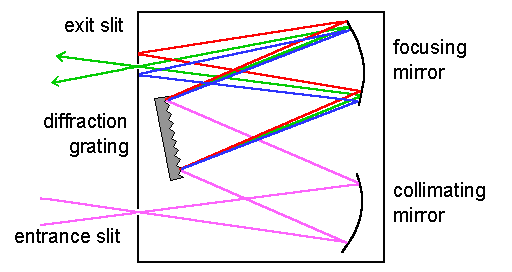Site pages
Current course
Participants
General
18 February - 24 February
25 February - 3 March
4 March - 10 March
11 March - 17 March
18 March - 24 March
25 March - 31 March
1 April - 7 April
8 April - 14 April
15 April - 21 April
22 April - 28 April
1.2.3.Monochromators
A monochromator is placed between the light source and the sample. It is an optical system which produces radiation of a single wavelength. It consists of either a prism or a rotating metal grid of high precision called gratings. If wavelengths are selected by prisms or gratings, it is known as spectrophotometry.
Diagram of monochromator Prisms are made of quartz or silica because glass absorbs wavelength less than 400 nm. Rotation of gratings or prisms perpendicular to the optical axis helps to select the different wavelengths. A prism splits the incoming light into its components by refraction. Refraction occurs as radiation of different wavelength travels along different paths. A grating splits the wavelengths by diffraction. Diffraction is a reflection phenomenon that occurs at a grid surface or engraved fine lines. Diffraction of light gives rise to a series of overlapping spectra. The bandwidth is a function of the optical slit width. The narrower the slit width the more reproducible is the absorbance values. On contrary, the sensitivity becomes less as the slit narrows because less radiation passes through to the detector. The resolution achieved by gratings is much higher than prisms. Gratings give high resolving power and it is directly proportional to the closeness of lines. Gratings can resolve lower wavelengths more than higher ones. |
